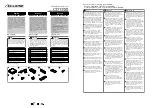
setun, it is necessar y to use an accurate si gnal gen
erator or preferably a signal generator and a fre
quency counter.
9.
Minimum Test Equipment for Installation
a.
Milliammeter 0-25 rna DC.
b. 60-ohm
5-watt
non-inductive resistor.
c. A-C Vacuum Tube Voltmeter (VTVM). Voltage
range
0 .003
to
30 volts, frequency range 60 Hz
to
230-kHz, input impedance 7 . 5 megohms.
d.
D-C Vacuum Tube Voltmeter (VTVM)
Voltage Range:
0. 15 to 300 volts
Input Impedance: 7. 5 megohms
10. Desirable Test Equipment for Apparatus
Maintenance
a. All items listed
in Sections
8
and
9 .
b. Signal Generator
Output Voltage:
up to 8 volts
Frequency Range: 20-kHz.
to
230-kHz.
c. Oscilloscope
d. Ohmmeter
e. Capacitor checker
f.
Test harness (See
Fig.
1 5)
A P P L I C A T I O N
1 .
Receiver Sel ectivity
( Fi g. 12)
This shows a
typical curve of the overall sel ec
tivity of
t h e r eceiver under steady state condi
tions.
2.
Transmitter Output Sel ectivity ( Fig.
10)
Typical curves ar e shown
so
that approximate
bandwiths for k eying purposes can be determi ned for
any carrier frequency between
30-kHz and 200-kHz.
3. Minimum Channel Spacing (Fig. 14)
This is a graph from which minimum channel
spacing can be obtained pr ovided the signal strength
of the interfering transmitter and the sensitivity set
ting of the receiver are known. These can be obtained
from calculations or by measurements.
For example, if the interfering transmitter volt
age is measured (at the receiver) and found to be 2. 5
volts, this would be 10-db down from 8 volts. This
point can be located on the right hand column of the
graph. Then, if the receiver sensitivity were set to
operate on 0 . 8 volts or 20-db , this point would be
located on the left hand column. A line could then be
drawn through the two points as shown by the dotted
line. The intersection of this line with the center
line indicates the minimum channel spacing. In this
case if the interfering signal is being keyed on-off, at
1 5 pp s,
the
minimum spacing would be 2. 5-kHz.
4.
Sup ervisory
Control
Connections
(Fig. 7)
When
supervisory
control is used with relaying ,
the
supervisory control relay coil is
connected in
series with the
RRH
coil in place of the alarm relay.
When supervisory control is used alone, a 1 200-ohm
resistor
R3
is connected in series with the control
relay coil by removing the jumper across R3, as shown
in Fig. 7.
In order to maintain proper mark space
ratio, the relay bias current
is adjusted
for 9 milli
amperes as indicated .
The receiver RF filter
and
the
I F filter limits
are
shown on Fig. 1 5 .
Both filters are of th e plug
in type and the test circuits with pin connections
are shown at the top of each curve. The
IF fili.<'r is
divided into two separ ate sections. The sel ectivity
shown is for each section, and the pin connections
for each section ar e also shown in the test circuit
sk etch.
9
www
. ElectricalPartManuals
. com
Summary of Contents for Type KR
Page 38: ...w w w E l e c t r i c a l P a r t M a n u a l s c o m...
Page 39: ...w w w E l e c t r i c a l P a r t M a n u a l s c o m...
Page 118: ...TYPE K R CARRI E R SET w w w E l e c t r i c a l P a r t M a n u a l s c o m...
Page 123: ...w w w E l e c t r i c a l P a r t M a n u a l s c o m...










































